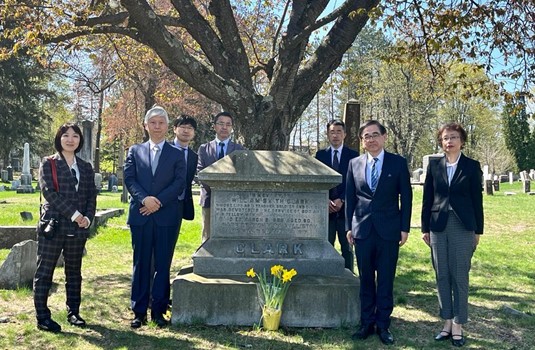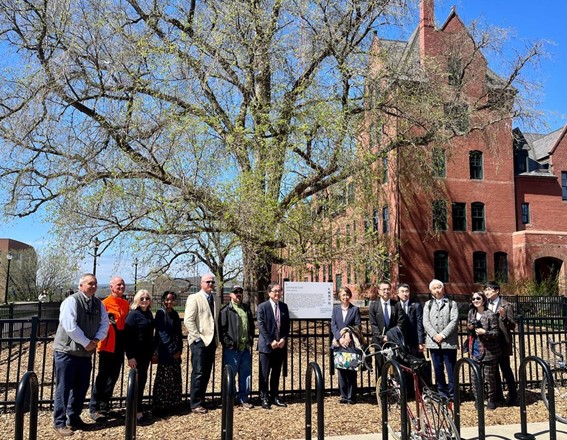Nostalgic visit to Massachusetts— Returning to an alma mater-in-spirit —
Two years and seven months have passed since I succeeded to the Office of President of Hokkaido University, and half of my term has just passed. As President of Hokkaido University, I have long wished to visit the grave of Dr. William Smith Clark, the first vice president of Sapporo Agricultural College (the predecessor of Hokkaido University). As I have confessed in a previous column, Dr. Clark is always staring at me through his portrait in my office. In the portrait he looks quiet and modest, but the real Dr. Clark must have been a very active and emotional person. He seemingly always urged me to visit his grave and exchange some words with him.
As the COVID-19 pandemic is now under control, I was finally able to visit the cemetery near the University of Massachusetts Amherst, where Dr. Clark is buried, following a visit to the University of California, Davis in the United States, from April 16, 2023. I hope you will take a moment to reflect on the life of Dr. Clark, who was one of Hokkaido University's most important figures.
I am sure all of Hokkaido University is familiar with Dr. Clark's main career and his famous words, "Boys be ambitious, like this old man." Dr. Clark, who himself served in the Union Army during the American Civil War, was active at the time when the war ended, and the United States was finally on par with the world powers. He was President of the Massachusetts Agricultural College, founded in Amherst, Massachusetts, located about 100 miles from Boston on the east coast of the United States.
Dr. Clark came to Hokkaido in 1876, soon after the Meiji Restoration, to support establishing Sapporo Agricultural College in the northernmost part of Japan. At the sincere invitation of the Meiji government, he came to a far foreign land, taking a one-year leave-of-absence from his position as President of Massachusetts Agricultural College. He crossed the North American continent (presumably by railway or coach), and then the Pacific Ocean to arrive in Tokyo, and then sailed further from Tokyo to Hokkaido. The exact population of Sapporo in 1876 is not known, but it is estimated to have been around 2,000. During his short eight-month stay in Sapporo, Dr. Clark established the foundation of Hokkaido University while sharing meals and sleeping quarters with more than 20 first-term students, and then bid farewell to his students at what is now Shimamatsu, close to Sapporo, before leaving Hokkaido like a gust of wind. He then returned to Massachusetts and set out to "startup business," in today's buzzwords, but following a combination of various misfortunes, he died just eight years later at the age of 60.
I believe that Dr. Clark's seemingly reckless undertaking was truly a life-risking choice. What drove him to take on such a challenge is beyond my imagination. However, looking back on his life, it was a life of challenges, and that "Boys be ambitious!" clearly expressed his very life. I believe that he was a man who did not seek fame and fortune, but rather set an example of how to live a life of “lofty ambition”.
Dr. Clark's gravesite is located in the center of a large cemetery near what is now the University of Massachusetts Amherst, the successor of the Massachusetts College of Agriculture, where he served as President. It is a very large tombstone and is still very carefully maintained. His grave is said to have been erected by his wife after his death, and like the graves in Japan, many of his blood relatives are buried there. On the headstone, the name William Smith Clark is engraved in large letters and his life story is described.

At the gravesite of Dr. William Smith Clark
In 1876, Dr. Clark crossed the Pacific Ocean with high aspirations, coming to Sapporo, in the northern part of Japan, where the wind and snow in winter were severe and harsh. When I thought of his unimaginable hardships and difficulties, I felt that our hardships and difficulties were really insignificant in comparison. I felt as if I had received words of encouragement once again from Dr. Clark at his gravesite.
The State of Massachusetts is well known for hosting a concentration of the world’s top universities, including Harvard University and the Massachusetts Institute of Technology (MIT); among these, the University of Massachusetts Amherst has earned a reputation as an outstanding comprehensive research-intensive land-grant university. Currently, private universities such as Harvard and Stanford have dominated academia in the United States based on their strong financial resources, but a recent trend has been the conspicuous development of major state universities. The University of Massachusetts Amherst is one such growing public university. In particular, it is producing world-class research excellence in informatics and computer sciences, agriculture, materials science engineering, and health care sciences.
For the University of Massachusetts Amherst, too, Dr. Clark was a special figure who laid the foundation for the University, and, even today, he is deeply respected and revered. In the center of the campus, a Japanese elm tree, brought back from Hokkaido by his successor, Dr. William Penn Brooks, has grown magnificently and is beautifully preserved 150 years after being planted. There is a building named after Dr. Clark, and the library is well-organized and houses many materials related to him. The spirit of those Americans to respect their predecessors in founding the school seemed to prevail over that of the Japanese in Hokkaido.
The Clark family indeed had many children and prospered, and even now, 150 years later, many descendants of the Clark family frequently visit our university. Early this year, Dr. Clark’s fourth-generation-descendants from New York visited Hokkaido University and my office. They were highly respectful and impressed by the achievements of William S. Clark, their great-ancestor.

In front of the elm tree that Dr. William Penn Brooks brought back from Japan
There are more than 800 universities in Japan; however, except for Hokkaido University, I do not think that there is any other national university that has such a strong sister relationship with an overseas university. I believe this relationship is an irreplaceable asset for us at Hokkaido University. I am confident that one of Dr. Clark's lofty ambitions is for the University of Massachusetts Amherst and Hokkaido University to maintain and deepen this unparalleled collaborative relationship in the future.
All through this trip to Massachusetts, a nostalgic sound has been echoing in my mind. It is the distinctive and beautiful falsetto sound of Robin Gibb in the Bee Gees' 'Massachusetts'! Every piece of music has a special meaning for someone. I feel as if this song was written for Dr. William S. Clark on his way back to his hometown, and all those associated with Hokkaido University, including myself.
Indeed, I felt as if I were returning to another of my alma maters.
”Feel I’m going back to Massachusetts
Something’s telling me
I must go home
And the lights all went out in Massachusetts …”
(Bee Gees. “Massachusetts.” Polydor, 1967)